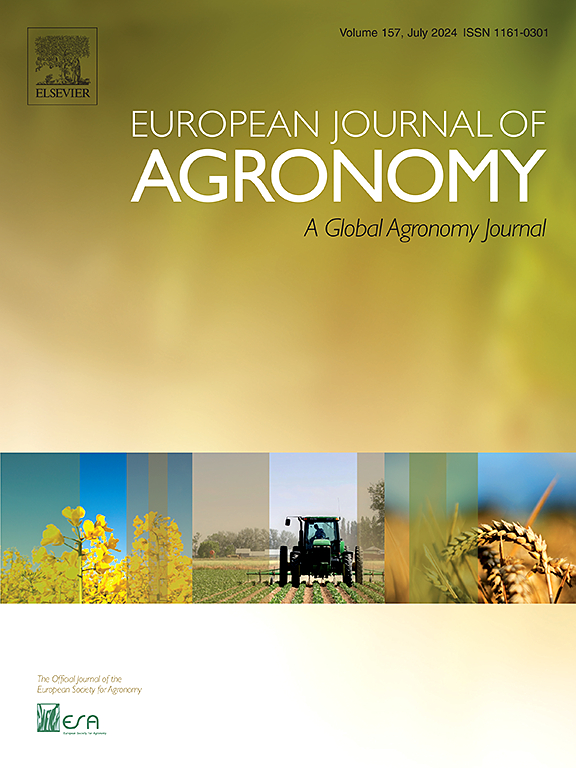Leaf phosphorus concentration as a diagnostic tool for predicting grape composition in subtropical viticulture
IF 4.5
1区 农林科学
Q1 AGRONOMY
引用次数: 0
Abstract
In subtropical viticulture, grapevines are cultivated in soils with low phosphorus (P) availability, requiring P fertilization to enhance their productivity. However, the relationship between grapevine yield and grape quality remains a matter of discussion. This study aimed to (i) investigate the effect of different rates of P application on grapevine yield and grape chemical composition, (ii) identify the trade-off between grapevine yield and grape composition, and (iii) characterize leaf P dynamics in response to P supply and use foliar P as a tool to predict grape composition. The investigation was carried out in southern Brazil, from 2016 to 2020, on 'Chardonnay' and 'Pinot Noir' (Vitis vinifera L.), fertilized with the following rates of (0, 10, 20, 40, 60, and 100 kg P2O5 ha−1) applied from 2011 to 2015. Hierarchical Bayesian models were used to obtain the most probable relationship between yield and P concentration in leaves for each grapevine cultivar. 'Chardonnay' and 'Pinot Noir' achieved their highest probable yields at 40 and 60 kg P2O5 ha−1, respectively. However, high grape yields triggered lower berry total soluble solids, total titratable acidity, pH; polyphenols, and anthocyanins. ‘Pinot Noir’ presented more stability for maintaining grape composition than ‘Chardonnay’ when compared at similar yield levels. Finally, the leaf P concentration at flowering resulted in an adequate indicator of soluble solids in berries, with a linear plateau association and a breakpoint for leaf P at 2.6 g P kg−1. These outcomes will assist the winegrower by anticipating the characteristics of grape products.
在亚热带葡萄栽培中,葡萄树是在磷含量较低的土壤中栽培的,因此需要施用磷肥来提高其产量。然而,葡萄产量与葡萄质量之间的关系仍是一个值得讨论的问题。这项研究的目的是:(i) 调查不同磷肥施用量对葡萄产量和葡萄化学成分的影响;(ii) 确定葡萄产量和葡萄成分之间的权衡;(iii) 描述叶片磷肥对磷肥供应的动态响应,并利用叶片磷肥作为预测葡萄成分的工具。这项研究于 2016 年至 2020 年在巴西南部进行,对象是 "霞多丽 "和 "黑比诺"(Vitis vinifera L.),施肥量分别为 2011 年至 2015 年的 0、10、20、40、60 和 100 千克 P2O5 ha-1。采用层次贝叶斯模型得出了每个葡萄栽培品种的产量与叶片中 P 浓度之间的最可能关系。霞多丽 "和 "黑比诺 "分别在每公顷施用 40 千克和 60 千克 P2O5 时获得了最高的可能产量。然而,葡萄产量高会降低浆果的总可溶性固形物、总滴定酸度、pH 值、多酚和花青素。在产量水平相似的情况下,"黑比诺 "比 "霞多丽 "更能稳定地保持葡萄成分。最后,开花时的叶片钾浓度是浆果中可溶性固形物的一个适当指标,叶片钾浓度在 2.6 g P kg-1 时呈线性高原关联和断点。这些结果将有助于葡萄种植者预测葡萄产品的特性。
本文章由计算机程序翻译,如有差异,请以英文原文为准。
求助全文
约1分钟内获得全文
求助全文
来源期刊

European Journal of Agronomy
农林科学-农艺学
CiteScore
8.30
自引率
7.70%
发文量
187
审稿时长
4.5 months
期刊介绍:
The European Journal of Agronomy, the official journal of the European Society for Agronomy, publishes original research papers reporting experimental and theoretical contributions to field-based agronomy and crop science. The journal will consider research at the field level for agricultural, horticultural and tree crops, that uses comprehensive and explanatory approaches. The EJA covers the following topics:
crop physiology
crop production and management including irrigation, fertilization and soil management
agroclimatology and modelling
plant-soil relationships
crop quality and post-harvest physiology
farming and cropping systems
agroecosystems and the environment
crop-weed interactions and management
organic farming
horticultural crops
papers from the European Society for Agronomy bi-annual meetings
In determining the suitability of submitted articles for publication, particular scrutiny is placed on the degree of novelty and significance of the research and the extent to which it adds to existing knowledge in agronomy.
 求助内容:
求助内容: 应助结果提醒方式:
应助结果提醒方式:


